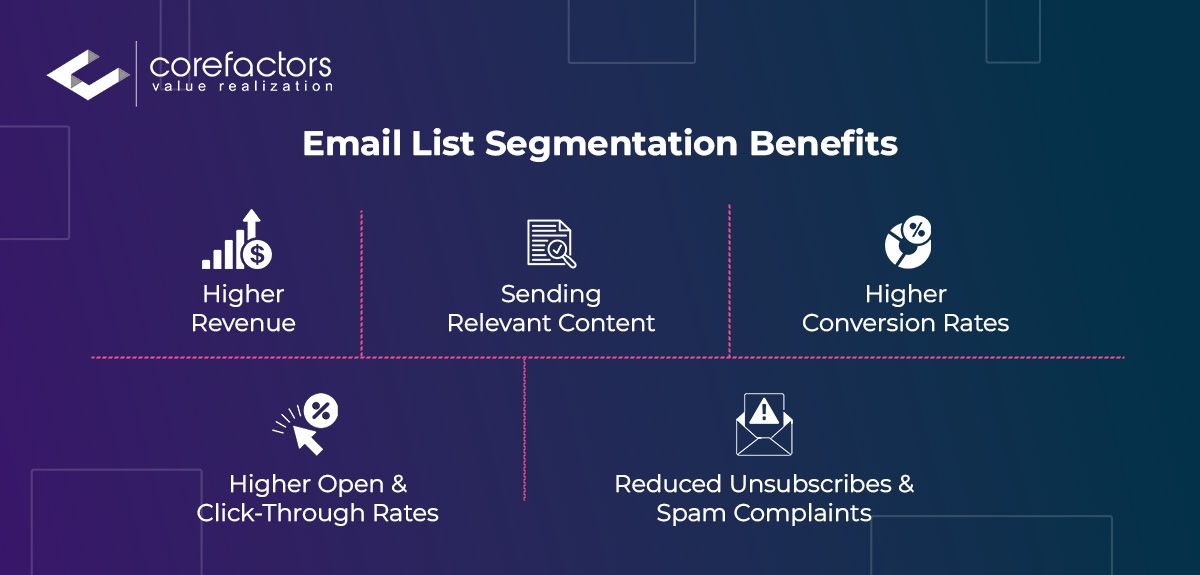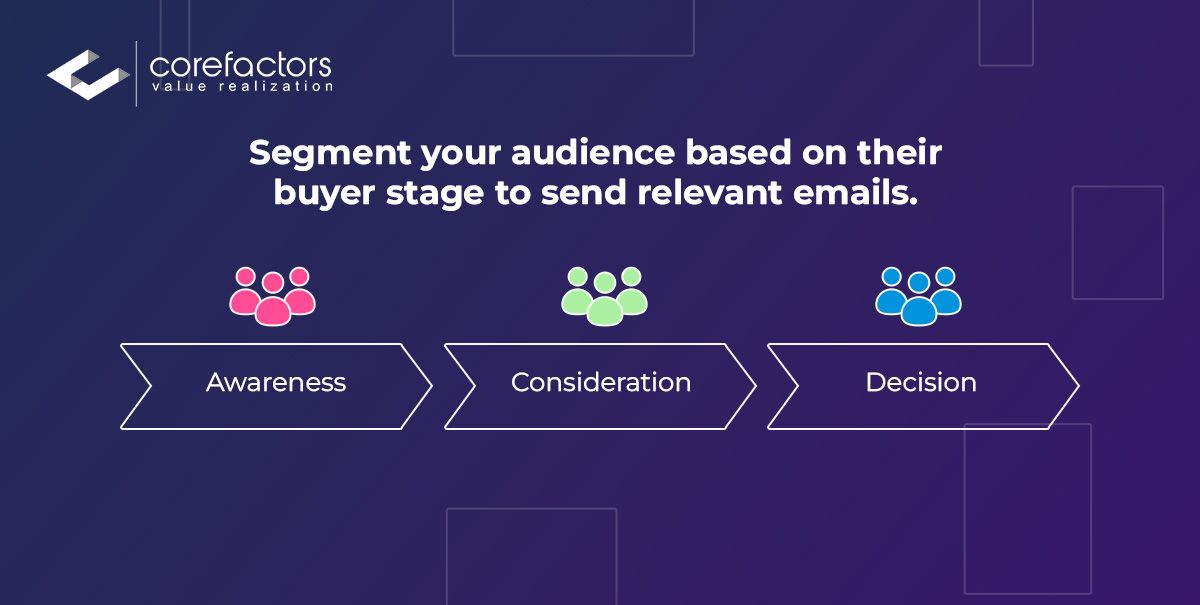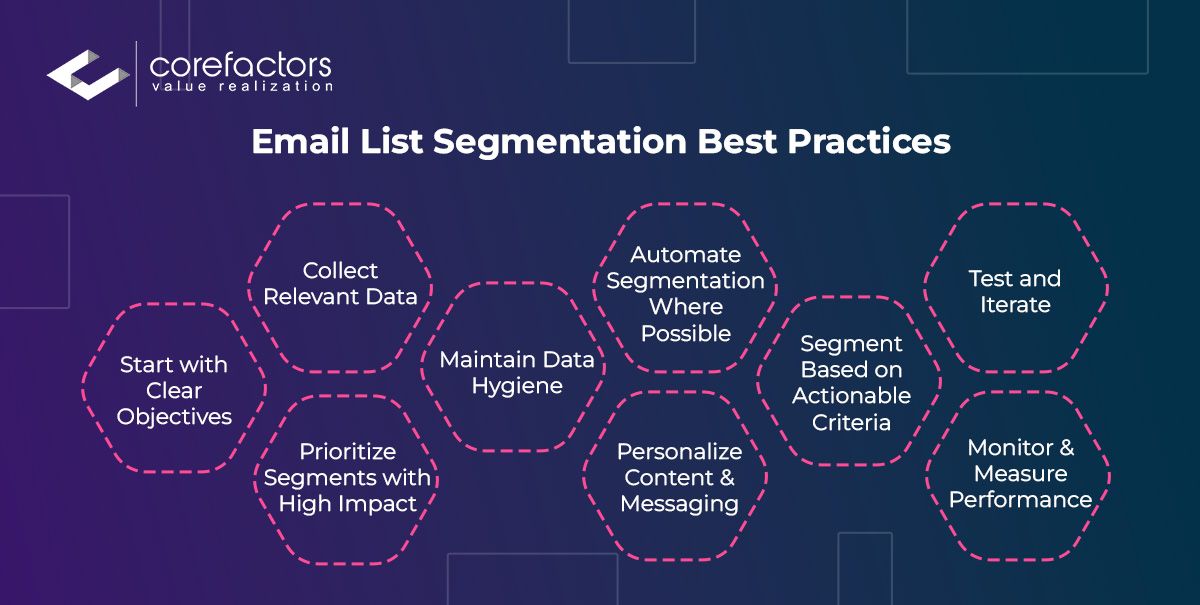Are you looking for the benefits of following email list segmentation best practices and driving more results through your email marketing efforts? You are in the right place.
This blog will help you understand the importance of email list segmentation and how it can help you achieve higher open rates, clicks, and conversions. But to do so, you should remember that generalization is our enemy and personalization is our best friend. Generalized emails run the risk of being ignored and ending up in spam and we definitely do not want that.
To start with email personalization, you must know what your audience wants.
To know what your audience wants, you must segment them into smaller groups - hence the need to learn about email list segmentation best practices.
So, let’s get started, shall we?
What is Email List Segmentation?
Do you send the same email, with a generic message, to all the contacts on your email list? If yes, you are missing out on sending relevant content to your audience and run the risk of being
- Ignored
- Marked as spam
- Unsubscribed
A simple way to get out of the rut of failed email campaigns is leveraging email list segmentation best practices. Divide your email list into smaller and targeted groups based on pre-defined criteria. This can be buyer history, demographics, age, and socio-economic status among other things.

Segmenting your email list allows you to send more targeted and personalized messages that resonate better with each group, leading to more clicks and opens, and ultimately, better conversion rates.
It helps deliver the right message to the right people at the right time, improving overall engagement and ROI from your email marketing campaigns.
Let’s look at how following some email list segmentation best practices can help your email marketing efforts.
Benefits of Email List Segmentation
Email list segmentation offers several benefits that can significantly enhance the effectiveness of your email marketing campaigns. Here are some key benefits.

- Higher Revenue
By tailoring content and offers to match the interests, preferences, and behaviors of each segment, marketers can drive higher conversion rates and maximize customer lifetime value. Targeted emails encourage subscribers to take desired actions, such as making purchases or completing conversion goals, leading to increased revenue generation.
Additionally, email list segmentation enables the identification of at-risk customers and the implementation of targeted customer retention strategies, reducing churn and preserving existing revenue streams.
2. Sending Relevant Content
Not all subscribers are at the same stage of their buyer’s journey when they receive your email.
A prospect does not have the same expectations as that of a repeat buyer. While the former will look for feature details and use cases for the first time, the latter will be more interested in upgrades and new feature releases that will elevate their experience. Surely, these two groups should not receive the same email.

Email list segmentation allows you to send targeted content relevant to specific groups of subscribers, increasing engagement and driving better results.
3. Higher Open and Click-Through Rates
Sending personalized emails to segmented lists often results in higher open rates and click-through rates compared to generic emails sent to the entire list.
A software company may segment its email list based on the subscriber's role or industry. They can send targeted emails highlighting features that are most relevant to each segment.
A message focusing on data security might be more appealing to IT professionals, while a message emphasizing productivity features might resonate better with business executives.
4. Higher Conversion Rates
Targeted emails that address the specific needs and pain points of each audience segment are more likely to lead to conversions.
You also need to remember that not all audience segments have the same revenue opportunity and potential. Segmentation allows you to focus more on high-potential prospects thus increasing their chances of conversions.
5. Reduced Unsubscribes and Spam Complaints
By segmenting your email list based on relevant factors you can deliver targeted messages that resonate with each segment, increasing the likelihood of positive interaction and reducing the risk of subscriber dissatisfaction.
When subscribers receive content that aligns with their interests and needs, they are less likely to perceive emails as irrelevant or intrusive, resulting in lower unsubscribe rates and fewer spam complaints.
Email list segmentation also allows marketers to send emails at optimal frequencies and times, avoiding overloading subscribers with excessive or unwanted messages or spamming.
What are Some Email List Segmentation Best Practices?
As discussed, email list segmentation is a powerful strategy for maximizing the effectiveness of your email marketing efforts. Here are nine best practices to follow for email list segmentation.

- Start with Clear Objectives
Before diving into segmentation, it's crucial to establish clear objectives for your email marketing campaigns. Define what you want to achieve, whether it's increasing sales, improving engagement, boosting retention, or driving website traffic.
Your segmentation strategy should align with these goals to ensure that your efforts are focused and targeted.
2. Collect Relevant Data
Gather the necessary data to effectively segment your email list. This includes demographic information, purchase history, website interactions, email engagement metrics, preferences, and any other relevant data points.
Use sign-up forms, surveys, tracking pixels, and CRM software to collect and organize this data in a centralized location.
3. Segment Based on Actionable Criteria
Segment your email list based on criteria that are actionable and relevant to your marketing goals.
Consider factors such as demographics, behavior, preferences, lifecycle stage, purchase history, engagement level, and channel preferences. Focus on segments that are likely to respond positively to targeted messaging and offers.
4. Prioritize Segments with High Impact
Identify segments that have the greatest potential to drive results and prioritize them in your segmentation strategy. This might include segments with high purchase intent, high engagement levels, or segments representing valuable customer segments such as VIPs or loyal customers.
Allocate resources and effort accordingly to maximize the impact of your segmentation efforts.
5. Maintain Data Hygiene
Regularly clean and update your email list with the help of an email verifier to ensure data accuracy and hygiene. Remove duplicates, outdated contacts, and inactive subscribers to maintain list health and deliverability.
Implement processes to keep your data clean and up-to-date, such as regular list hygiene audits, preference management, and re-engagement campaigns for inactive subscribers.
6. Test and Iterate
Continuously test and refine your segmentation strategy to optimize performance and results. Experiment with different segmentation criteria, messaging strategies, and content formats to identify what resonates best with each segment.
Use A/B testing, multivariate testing, and analytics to measure the impact of your segmentation efforts and make data-driven decisions.
7. Personalize Content and Messaging
Tailor your email content and messaging to each segment to increase relevance and engagement.
Use dynamic content, personalized recommendations, and targeted offers to deliver messages that speak directly to the interests, preferences, and needs of each segment. Personalization can significantly improve your email campaign metrics.
8. Automate Segmentation Where Possible
Leverage workflow automation to streamline the segmentation process and deliver targeted emails at scale.
Set up automated triggers and rules based on subscriber behavior or attributes to dynamically segment your list and send personalized emails in real time. Automation can save time, reduce manual effort, and ensure consistency in your segmentation strategy.
9. Monitor and Measure Performance
Regularly monitor the performance of your segmented email campaigns and analyze key metrics such as open rates, click-through rates, conversion rates, revenue generated, and customer lifetime value.
Use analytics and reporting tools to track the impact of segmentation on your overall email marketing performance and ROI. Adjust your segmentation strategy based on insights gained from performance data to continuously improve results.
As mentioned in the third point, one of the important email list segmentation best practices is to choose the basis on which you will segment your email lists.
So, how Should You Segment Your Email Lists?
There are several criteria you can consider while segmenting your email list. The table below shows the major ones.
Divide and Rule: A Strategy with a Positive Outcome
As discussed in this article, email list segmentation is one such strategy that cannot be overlooked for a successful campaign. However, only 31% of businesses use basic segmentation to send out emails.
It might be because they do not have the right tools to carry out effective segmentation. Having a CRM platform that also comes with targeting, segmentation, and personalization capabilities is a godsend.

Frequently Asked Questions (FAQs)
1. What is email market segmentation?
It is the practice of dividing an email subscriber list into smaller, more targeted segments based on specific criteria such as demographics, interests, behaviors, or engagement levels.
2. How do you segment email marketing leads?
There are several criteria you can consider while segmenting your email list such as demographic, behavioral, preference, lifecycle stage, psychographic, firmographic, etc.
3. What are some email list segmentation best practices?
Email list segmentation best practices include starting with clear objectives, collecting relevant data, segmenting based on actionable criteria, prioritizing segments with higher impact, and maintaining data hygiene, among others.
4. What are the benefits of email list segmentation?
Segmenting your email lists provides multiple benefits such as increased conversion, open and click-through rates, revenue, and reduced unsubscribe and spam rates.







